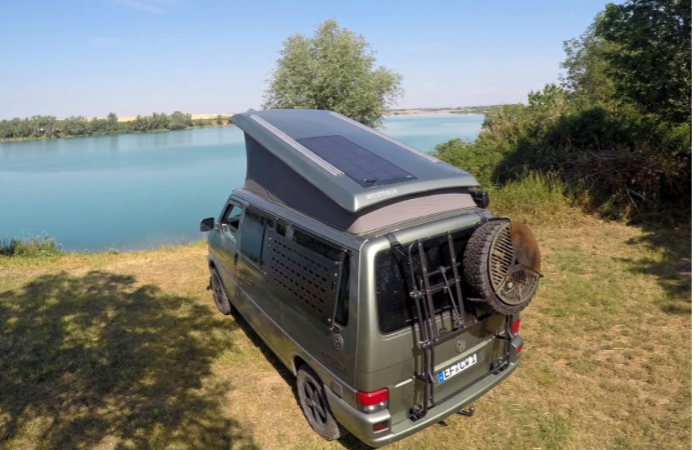More and more people love to travel with a mobile home. Off to nature. A spontaneous weekend trip, a vacation in the summer, or a few months to “hibernate” in southern climes. Discover the fascinating mountains of other countries, unwind on crystal-clear lakes and lonely beaches, and immerse yourself in foreign cultures. Just leave the hustle and bustle of office and city life behind for a while.

And don’t do without the “little” comforts of life, such as a fresh omelet with coffee in the morning or the constantly charged batteries of e-bikes, notebooks, cameras, etc. However, self-sufficient standing also means well-considered planning for sufficient power reserves, storage space, and a correctly dimensioned solar module.
How do I Plan the Right Solar System for Me?
It’s not as complicated as it sounds, and we’ll show you how to turn your plan into a result in a few steps. You have already taken the first step by opting for a solar system and thus for your free electricity in your mobile home.
In the second step, you will find out what type of traveler you are: Do you love the colorful campsite life, and do you regularly supply your camper with shore power? Or do you prefer secluded places in the middle of nature where you would like to stay a little longer? You’ve already noticed: the stronger your desire to be flexible and self-sufficient on the road, the more solar power you’ll need.
Then take some time and, in the third step, think about which electrical devices you want to have and use on your travels.
- lighting
- Kitchen appliances (e.g., fridge, kettle, hot plate, coffee maker)
- Household appliances (e.g., TV, DVD, hair dryer, fan, heater, vacuum cleaner)
- Batteries for laptops, smartphones, e-bikes, drones, Tonie boxes, toothbrushes, etc.
- Tools
Here, the principle applies the more consumers you want to use on the go, the greater your electricity and storage requirements.
The fourth step gives you the best overview of your consumption with a short list of your devices, their power (watts), and the estimated usage time (per day).
An example:
- Smartphone: 10 watts * 2h = 20 Wh
- Fan: 50 watts * 5h = 250 Wh
- Kettle: 1000 watts *1.5h = 1500 Wh
In the fifth step, you can convert the determined daily consumption of 1770 Wh into your daily electricity requirement (Ah) using the following formula:
Ah = 1770 Wh x 1.2 / 12 V = 177 Ah (systems with inverter and 12 V system voltage)
This is the basis for all further calculations, bringing us to the sixth step. How many watts does my solar panel need to cover my daily power requirements (Ah)?
The formula: Rated power (Wp) x 0.75 x hours of sunshine (h) / system voltage (battery)
For example, connecting a 340 Wp solar bag in summer with very good conditions and 10 hours of sunshine would supply your lithium leisure battery or power station with a good 200 Ah that day. Your needs would be easily covered.
Which Power Station Can I Use to Operate My Cool Box?
It’s summer – it’s warm outside, and you fancy a cold beer at sunset? Sound too romantic? With the current temperatures, that’s a nice view for the next holiday in the warmth. If you are traveling with a mobile home, you usually cannot avoid buying a cool box for the cool beer in the evening and for any food that needs to be stored cool. This article explains which power station you need to operate which cool box.
Which Cool Box for a Power Station?
How to live off the grid? Before we talk more about the selection of the power station, we first have to clarify which cool box is compatible with a power station. We can therefore be operated with a mobile power supply. This is the case with a compressor cooler designed for use in the car, RV, or campsite. The market for compressor refrigerators is also large. We recommend a box with a standard 230-volt and a 12-volt connection. Ideally also with a 24-volt connection, which can be relevant for large motorhomes or trucks. The cool box can be charged with the car battery while driving. But it only gets interesting when the campsite is reached, the car is stationary, and the cool box should continue to be used. This is where the power station comes into play. This can supply the cool box with electricity and can be charged while driving via the cigarette lighter in the car and when stationary via solar modules. This guarantees that the cool box is continuously supplied with electricity and the car battery is protected against discharging. A power station is a super practical investment here. Because if the cool box runs on the car’s starter battery even when stationary, it draws too much electricity. If it runs via the external connection of a campsite, it can be charged indefinitely, but there must always be a connection fee and on-site, and you are very dependent on shore power.
Energy-Saving Compressor Cool Box
We are presenting a cool compressor box that is comparatively economical in consumption and perfectly compatible with a power station. The Dometic compressor cool box has 12/24 volt and 230-volt connections. It is perfectly suited for car, truck, or mobile home operations. It can be charged from the cigarette lighter while driving, from a stationary power station, and a socket if there is access to shore power. The box has a power consumption in standby mode at 12 volts and 0.03 amps, i.e., a minimum of 0.3 watts. When the compressor runs, the power consumption increases to 12 volts and 3.3 amps, which is still a manageable 40 watts. The cool box only consumes these 40 watts when the compressor is running. When the desired temperature is reached, the cooling only switches on when required. The day has 24 hours, of which the compressor runs for about 8 hours. That means we then have a requirement of 320 Wh (8 x 40 W). We can now work with these values to search for a suitable power station.
Higher Performance with Inductive Consumers
Suppose we need a power station for a more powerful and larger cool box or a refrigerator to be operated in the pavilion. In that case, we naturally also need a more powerful power station. Refrigerators also have a special feature to be observed; they belong to so-called inductive consumers. These are devices that an electric motor must power. A high starting current is required to start the motor, which is much higher than the actual rated current (i.e., the continuous power that occurs as soon as the motor is running). You can expect a fridge to use three to four times its rated power when you turn it on. This means that if the refrigerator we want to operate with a power station has an output of 120 W, it needs around 480 W to start. The power station has to do more at the start until consumption levels off at the continuous output of 120 W.
Calculate Your Consumption
The purchase of a power station is expensive, and you should research well how much consumption you have with your cool box. Compressor cool boxes are ideal for travel because they are compatible with power stations and are comparatively space-saving and light. They are low in consumption and therefore do not require an extremely powerful power station. However, if you need a large cool box or a refrigerator, your consumption will quickly look very different. We, therefore, advise you to consider in advance what type of cool box you need and how much power it needs to operate. As in the examples above, you can calculate your consumption to find the right power station.












